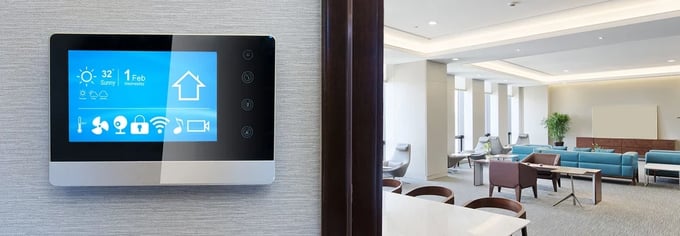The term "smart building" gets thrown around a lot. But what about a building makes it "smart?" How can a building even be intelligent?
We're going to unravel these questions: our goal is to make sure you, as someone building, buying, designing, or investing in smart buildings and their underlying technologies, know what's available for you.
What exactly is a smart building?
The word smart concerning buildings or their related technologies is essentially a product of marketing.
It's a simple phrase that masks the complexity of specialized design, labor and technology. It makes it easy to sell to the technically uninformed and uninterested, only focusing on the outcomes and benefits you can get out of it.
But if you're reading this, we're assuming you want to be a bit better informed about all the options and what might be best for your building. So you need to know what's what.
All smart technology has two intertwined goals: awareness and control. For a building, this means knowing more about what is happening in and to the structure, and increased control over its operations and environment.

In practice, this usually involves three technologies:
- Sensors and other data-collecting tools measure different aspects of a building.
- Networking infrastructure collects and monitors the gathered data and relays this information to users.
- Automation software and tools optimize the building's systems in response to incoming data, usually for comfort, safety, and efficiency. Human operators can also use these to intervene in the building's operations as needed, often remotely.
Many smart technology vendors offer tools to analyze data about a building. In some cases, these tools can even analyze data around the building. This is particularly true for vendors selling networking and automation. These will frequently employ algorithmic or machine-learning processes to assist a facilities manager in making decisions about the building's systems.

The smart technologies you need to know about
Smart HVAC
This is perhaps the most familiar smart technology for most people. The smart thermostats from Google's Nest devices and Amazon's Honeywell-built products have been heavily marketed to residential homeowners.
It's also one of the most straightforward kinds of smart technology to implement. For decades, buildings have digital wall-mounted controls for a building's heating, cooling, and air quality control. Making them smart is often just a matter of adding controls with networking capabilities.
Commercial buildings have many features to offer beyond what is used to create a smart home. Investigate what is available to you. For example, you can save money by remotely controlling the comfort of your building's occupants. This involves not needlessly heating or cooling rooms that are not being used.
Commercial building sensors include monitoring aspects like humidity, air pressure, and CO2 levels. In the case of Siemens' Variable Air Volume system, it can manage air purification systems to limit virus and bacteria spread.
Smart lighting
This is the other kind of smart technology that most people are familiar with. It's already been heavily marketed to consumers in their homes.
The main draw of smart lights is cost savings. Energy costs for unused lights can quickly accumulate. We often overlook how many kilowatts we use to light up empty rooms. But smart lighting capabilities can go much farther than a motion sensor that checks if anyone's in the room before turning the lights out.
Manufacturers have long been able to make lights with adjustable light balances. Integrated into a smart building's systems, you can have lighting inside that mimics light conditions outside. It makes living and working inside more comfortable and uses less energy than the harsh fluorescent bright lights common in commercial and industrial buildings.

Smart water management
After energy, water is the other utility that building owners and facilities management focus on for efficiency savings. Smart water management is easy to deploy – all buildings have key points where water enters and leaves.
Much of the work involves strategic planning. Smart Sensors must be placed in the correct areas in order to give an early warning of a leak or flood. We need to pair this with a strong local network. This will give us the capability to see water damage in places that are not visible.
Smart water management protects and saves on three levels:
- Reducing the cost from water loss (known as non-revenue water).
- Warning you early, limiting possible damage from leaks or floods.
- Creating reduced insurance costs due to the significantly lower risk the system brings.
We've previously written about the different kinds of water sensors and how they can benefit you. We also pair our water sensors with our LAIIER Cloud system that manages liquid leak sensors and integrates this with various other data sources from your building.
Smart occupancy management & security
Introducing any of the above smart technologies we've covered above will likely include a need for occupancy sensors. This isn't very new technology – building security needs have already put cameras and motion sensors in almost all modern commercial buildings.
What has changed is the development of more advanced and sophisticated systems that can help you improve occupant comfort. Sensors, like those made by Purple, can now near-perfectly track how many people are in a room. If it gets too crowded or noisy, you can plan and move people to quieter, less busy spaces.
Smart windows
Smart windows are probably best paired with smart lighting and energy management. Also known as smart glass, windows, like those made by View, can respond not just to occupancy needs but also to light conditions outside. They can dim themselves without the need for blinds to reduce glare from direct sunlight and adjust for optimal lighting over the day in concert with your lighting inside.
Additionally, smart windows can help enormously with controlling heat levels, supporting your HVAC system by reducing the radiative heat effect of the glass. With this technology integrated, you can also turn your windows into built-in digital displays and send you a security warning should anyone try to break one.
Smart disaster management
This last one might be a bit dependent on where your building is. Still, there is an ongoing development of smart building technologies that can warn you about threats and assist you in identifying damage and assessing structural integrity after a disaster.
For example, Grillo makes sensors and networking tools that can monitor for and give you an early warning of an earthquake long before you can physically feel it.
They also make sensors that monitor your building for damage. Earthquakes can cause a phenomenon known as inter-story drift in multi-story structures. This occurs when one or more levels of a building move out of alignment with each other.
This causes structural weakness that may not be visually apparent but is a danger to anyone reentering the building. Grillo's sensors measure the building's alignment, warning you if the structure is too damaged or unstable to reenter safely.
Learn more about smart building technology
Smart technologies are available in many varieties. They are designed to make your building more efficient and secure. In addition, they provide a comfortable environment to work and live in.
If you found this interesting and want to learn more, we have more articles about the different aspects of the sensors and tools we use, including LoRaWAN – the type of wireless technology our sensors use to communicate with the local network – and how these technologies can be used to improve the work environment and efficiency of office buildings.